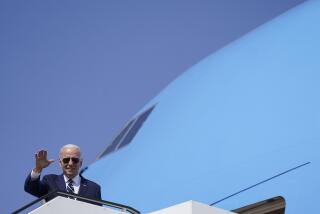U.S. Diplomats Turn Efforts to Boosting Trade : Commerce: Touring ambassadors urge American business people to invest in the booming economies of Southeast Asia.
- Share via
A T-shirt noticed recently in Singapore by Steve Craven, senior commercial officer at the U.S. Embassy, seemed to sum up a prevailing value in that trade-rich city-state. Starting with big letters at the top and repeating in descending rows of smaller and smaller type, it declared: “MONEY, money, money, money, money . . .”
Indeed, the importance of money is one of the few things the American government and its increasingly assertive Asian trading partners can agree about these days, after the debacle of Washington’s human rights standoff with Beijing and the caning of an American youth accused of vandalism in Singapore.
The Clinton Administration says trade and human rights are now officially de-linked, and with security issues on the back burner after the end of the Cold War, the U.S. diplomatic corps in Asia is redefining itself as a cheerleader for American businesses. Economic security, with an emphasis on American jobs generated by exports, is at the forefront of U.S. foreign policy.
To underscore that point, a band of American ambassadors and their top commercial aides are touring major U.S. cities, spreading the gospel of trade and investment in the booming economies of Southeast Asia.
Their message, delivered to a ballroom full of business people at a downtown Los Angeles hotel last week, was loud and clear: To take advantage of the lucrative opportunities in Asia, you have to go there, establish a presence in a challenging business environment and patiently build relationships over time.
“There are opportunities out there, but you’re not going to be able to exploit them by using a fax machine or hiring an agent,” said Robert Barry, ambassador to Indonesia, which not many Americans realize is the planet’s fourth-most-populous country.
“On a perception basis, Indonesia is the most underestimated country in the world,” Barry said. “But there are too few American companies going there and looking seriously at this market of 190 million people.”
The touring diplomats come from the capitals of the six-member Assn. of Southeast Asian Nations, or ASEAN, a group consisting of Indonesia, Thailand, Malaysia, the Philippines, Singapore and the tiny oil sultanate of Brunei. They are scheduled to appear in Seattle today, then travel to Denver, St. Louis and New York in a program organized by the Washington-based U.S.-ASEAN Council.
The promotional blitz, being repeated for the third year, is aimed primarily at small and medium-size U.S. firms--on the assumption that while many major U.S. corporations are already well placed in Asia, smaller companies have been complacent and lack savvy about how to tap into the region’s phenomenal economic growth.
“Opportunities don’t come to you, you’ve got to take the initiative,” said John Wolf, ambassador to Malaysia. “If you wait to read about a (procurement) tender offer, it’s too late. You’re going to find your competitor is already in there.”
Part of the ambassadors’ effort goes to changing the image of American embassies abroad, from foreboding high-security bunkers to business-friendly service centers.
In Jakarta, the Indonesian capital where President Clinton is expected to attend a summit of Asian leaders in November, the U.S. commercial service is creating a “one-stop shop”--outside the gates of the embassy compound--to serve U.S. business visitors.
Although the developing economies of Southeast Asia are dwarfed by major U.S. trade partners in Asia--such as Japan, China and South Korea--they boast some of the most dynamic growth rates in the world. Last year Singapore’s economy grew by 9.7% and Malaysia’s by 8.4%; ASEAN’s combined average growth is 7%.
“Over the next five years, the economies of Southeast Asia will generate more economic growth than the entire Mexican GNP,” said Ralph Boyce, U.S. charge d’affaires in Singapore.
ASEAN, with a total population of 328 million, is the third-largest overseas market for U.S. exports, after Japan and the European Union, buying more than $28 billion in U.S. goods last year, according to the U.S.-ASEAN Council. California alone exported more than $8 billion worth of goods to ASEAN--including $5.3 billion in computers, machinery and electronic goods.
Even the Philippines, the laggard of ASEAN, now has political stability and offers opportunity for U.S. investors and exporters, said John Negraponte, ambassador to Manila. “It’s not certainly going to become a tiger, or a tiger cub, right away,” Negraponte said. “But the Philippines is on the move and should be taken seriously.”
The key to success in any Asian market, the diplomats agreed, is building relationships with local partners, and making a commitment to a marketplace that probably won’t yield immediate profits.
“The Indonesian partner has got to be comfortable with you,” said Ted Villinski, senior commercial officer in Jakarta. “Having the right product at the lowest price is not sufficient. It takes patience. You have to develop that personal relationship and you have to be there physically in the country.”
More to Read
Sign up for Essential California
The most important California stories and recommendations in your inbox every morning.
You may occasionally receive promotional content from the Los Angeles Times.













